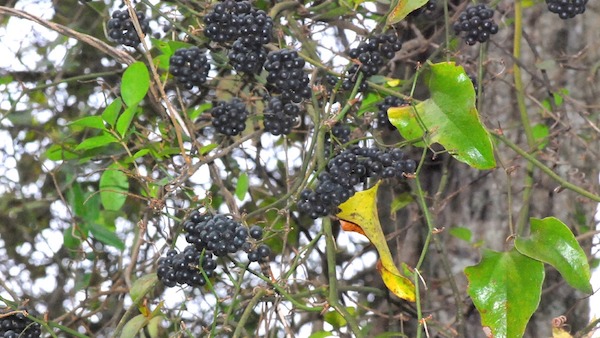
By Terry W. Johnson
If you are like me, over the winter you spent a few days working in the yard preparing for the spring growing season. If such is the case, chances are you became reacquainted with a vine known as greenbrier. When the plant's abundant thorns snag your clothing or pierce you skin, you are not apt to forget the encounter.
The native plant I am referring to is also known by names such as horsebrier, sawbrier, smilax and catbrier. All told, some 14 species of greenbrier spread their green, woody vines across the Southeast. Although some species do not have sharp spines, we are most familiar with those that sport enough of them to earn the vine the nickname “nature's barbed wire.”
Depending on the species, the vine's leaves are often heart-shaped and can be either evergreen or deciduous. In winter it is easy to spot greenbrier vines adorned with shiny dark green leaves. Indeed, I must admit they bring a touch of color to a winter landscape dominated by gray and brown hues.
Greenbrier thrives in a wide range of habitats. You will find it growing all the way from moist creek bottoms to dry uplands. It is also able to exist in both shade and full sunlight.
Much to the chagrin of Georgia gardeners, greenbrier also has a propensity to thrive in our yards. In mine, I find it trying to gain a foothold in my flower gardens, interlaced with the limbs of my azaleas, trailing along my fences and trying to climb to the tops of my tallest trees.
Greenbrier vines emerge from rhizomes. I have long been amazed how far greenbrier vines can venture out from these gnarly, fleshy root-like structures. I have found greenbrier vines that were 30 to 40 feet long. Yet, I cannot help but wonder how long they can get.
The vines also can attain dizzying heights with the aid of tendrils that extend from joints spaced along their vines. Once a tendril touches any means of support, such as a twig, it quickly wraps itself around it. Consequently, as the vine grows skyward, a network of sturdy anchors that help hold it aloft.
Those vines that grow close to the ground form seemingly impenetrable thickets. If you have ventured into a greenbrier thicket you can attest that the experience is often a nightmare.
In spite of the fact that such patches of thorn-laden vines are despised by homeowners, they provide both nesting and escape cover for wildlife varying from quail to songbirds and rabbits.
Well more than a century ago Eatonton native Joel Chandler Harris wrote a humorous Uncle Remus tale that vividly illustrates the value of brier patches to rabbits. The story reveals how Brer Rabbit tricked Brer Fox into throwing him into a briar patch. As we all know, what the supposedly wily fox didn't realize is that the dreaded briar patch would offer Brer Rabbit thorny protection from the hungry fox.
Nowadays, rabbits are still using greenbrier patches to escape foxes and coyotes, as well as hawks and other predators.
Greenbrier vines are dioecious, meaning they are either male or female. Female vines bear 1/4- to ½-inch fruits that turn blue, red or black when mature. Each fruit contains one to four seeds.
These fruits will often remain on the vines well into winter and provide food for more than 40 songbirds, including hermit thrushes, sparrows, cardinals, American robins, gray catbirds, fish crows, wild turkeys, common grackles, northern flickers and mockingbirds. This past winter I watched a mockingbird eating greenbrier fruits more than 26 feet above the ground.
The fruits are also devoured by opossums and black bears. White-tailed deer, eastern cottontails, and swamp rabbits will eat greenbrier leaves and vines. Believe it or not, beavers will even feed on the rhizomes.
Greenbrier is also important to a fascinating little butterfly known as the harvester. The small, rarely seen butterfly is our only carnivorous butterfly. The harvester lays its eggs on greenbrier leaves. The butterfly does not do this because its caterpillars feed on the plant's leaves. To the contrary, its caterpillars eat wooly aphids that suck juices from the leaves.
The food value of the greenbrier has long been recognized by humans. Some folks mix greenbrier in their salad greens. Others use it to make jelly.
Native Americans used greenbrier to treat urinary infections and joint pain. In the past, the perennial vine also was used to treat gout and skin diseases. Greenbrier tea was sipped to alleviate joint pain.
When we take the time to learn more about this thorny vine, it is obvious greenbrier does have some redeeming values. As such, while I have been fighting a decades long battle to keep greenbrier out of my trees, gardens and shrubs, I do allow it to trail through the undeveloped spots on my property.
Despite this, I must agree greenbrier still deserves the nickname of nature's barbed wire.
Terry W. Johnson is a former Nongame program manager with the Wildlife Resources Division and executive director of The Environmental Resources Network, or TERN, friends group of the division’s Nongame Conservation Section. (Permission is required to reprint this column.) Learn more about TERN, see previous “Out My Backdoor” columns, read Terry’s Backyard Wildlife Connection blog and check out his latest book, “A Journey of Discovery: Monroe County Outdoors.”
 An official website of the State of Georgia.
An official website of the State of Georgia.
















